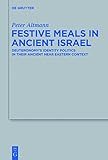Festive Meals in Ancient Israel : Deuteronomy's Identity Politics in Their Ancient Near Eastern Context / Peter Altmann.
Material type: TextSeries: Beihefte zur Zeitschrift für die alttestamentliche Wissenschaft ; 424Publisher: Berlin ; Boston : De Gruyter, [2011]Copyright date: ©2011Description: 1 online resource (300 p.)Content type:
TextSeries: Beihefte zur Zeitschrift für die alttestamentliche Wissenschaft ; 424Publisher: Berlin ; Boston : De Gruyter, [2011]Copyright date: ©2011Description: 1 online resource (300 p.)Content type: - 9783110255362
- 9783110255379
- 222.15083942 222/.15083942
- BS1275.6.D55 A48 2011
- online - DeGruyter
- Issued also in print.
| Item type | Current library | Call number | URL | Status | Notes | Barcode | |
|---|---|---|---|---|---|---|---|
 eBook
eBook
|
Biblioteca "Angelicum" Pont. Univ. S.Tommaso d'Aquino Nuvola online | online - DeGruyter (Browse shelf(Opens below)) | Online access | Not for loan (Accesso limitato) | Accesso per gli utenti autorizzati / Access for authorized users | (dgr)9783110255379 |
Browsing Biblioteca "Angelicum" Pont. Univ. S.Tommaso d'Aquino shelves, Shelving location: Nuvola online Close shelf browser (Hides shelf browser)
Frontmatter -- Acknowledgements -- Table of Contents -- Abbreviations -- Introduction -- 1. Overview of the History of Scholarship of Deuteronomy -- 2. Treatment of the Deuteronomic Cultic Meals -- 3. Material Culture and the Symbolic Meaning of Meat in Deuteronomy 12 -- 4. The Cultic Meals of the Deuteronomic Cultic Calendar (16:1-17) in Light of Comparative Ancient Near Eastern Texts -- 5. Deuteronomy 14:22-29 in Light of Ancient Near Eastern Tribute and Modern Anthropology -- 6. Conclusion -- Index
restricted access online access with authorization star
http://purl.org/coar/access_right/c_16ec
The festive meal texts of Deuteronomy 12–26 depict Israel as a unified people participating in cultic banquets – a powerful and earthy image for both preexilic Judahite and later audiences. Comparison of Deuteronomy 12:13–27, 14:22–29, 16:1–17, and 26:1–15 with pentateuchal texts like Exodus 20–23 is broadened to highlight the rhetorical potential of the Deuteronomic meal texts in relation to the religious and political circumstances in Israel during the Neo-Assyrian and later periods. The texts employ the concrete and rich image of festive banquets, which the monograph investigates in relation to comparative ancient Near Eastern texts and iconography, the zooarchaeological remains of the ancient Levant, and the findings of cultural anthropology with regard to meals.
Issued also in print.
Mode of access: Internet via World Wide Web.
In English.
Description based on online resource; title from PDF title page (publisher's Web site, viewed 28. Feb 2023)









